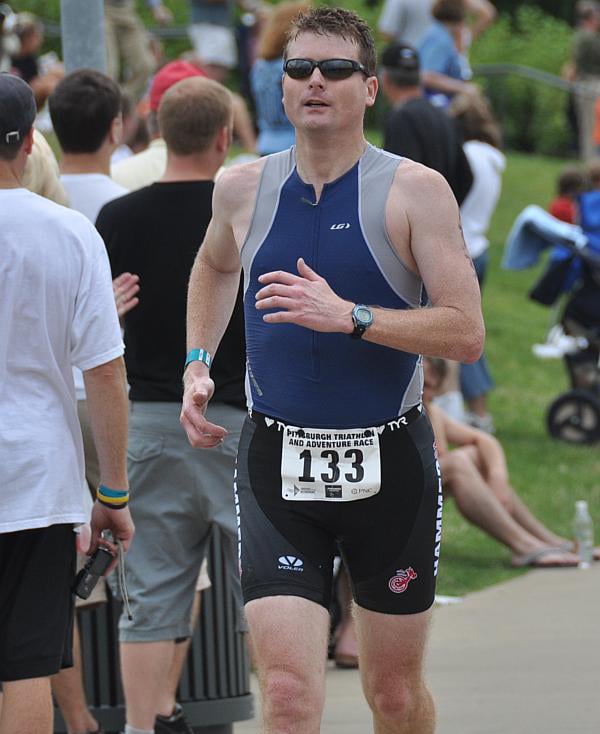Seasoned athletes such as 45-year-old Niel Beggy of Kensington realize injuries such as torn ACLs come with the territory of being an Ironman. So when Beggy visited his doctor to examine a possible re-injury—he’d already had an ACL replacement—he sustained while skiing, he assumed it was a routine visit.
However, an X-ray and an MRI came back inclusive. When Beggy’s knee pain disappeared a few days later, he chalked it up to age and strain from physical activity.
Eventually, his doctor called back with shocking news: Beggy had cancer. Further tests revealed that two-thirds of the bone marrow in his femur was engulfed with a growth that had penetrated through the bone into his knee.
Doctors told Beggy he might lose his leg.
The thought devastated the father of three and competitive triathlete, so he sought another medical opinion from Mayo Clinic. This time, the results returned with a solid diagnosis of non-Hodgkin lymphoma, which meant Beggy would keep his leg, and he had a 65 percent chance of survival after five months of chemotherapy.
That was two years ago, and Beggy is still in remission. However, this local athlete isn’t sitting on the sidelines. He heads to Kona, Hawaii, next month for the Ironman World Championship—a grueling 140.6 miles of swimming, biking, and running.
Well+Being was able to chat with Beggy about his training before he heads off to compete in his fifth Ironman.
How did you begin your Ironman career?
Rob Pumphrey, a lifetime friend of mine, loves triathlons. When we were out one night he said he was going home early because he had to bike 56 miles the next morning. He was training for the SavageMan, a triathlon in western Maryland. After I gave him grief for wanting to go home, he said, “I’ll stay if you train with me and do the SavageMan.” Upon hearing that, our mutual friend laughed so hard and said to me, “Niel, you could never do the SavageMan.” Four months later I completed my first triathlon, and five months following I completed my first SavageMan. At that event, the winner said that anyone who finishes the SavageMan is 80 percent of the way toward completing an Ironman. That is all I needed to hear, and I had my sights set on a full-distance Ironman.
We know there are three ways to land a spot at the starting line at the Ironman Championships—a qualifying event, a lottery, or an eBay auction. How did you earn your spot?
I was fortunate to win a lottery spot—just 1 of 100 awarded each year. For that I am grateful, but respectful of the true athletes that will be competing. I stand in amazement of those athletes. They had to place in their age group in earlier Ironman events in order to secure a spot at the Ironman World Championship. It will be great to watch them race by me!
Which event is your strongest in the competition—swim, bike, or run?
I excel on the bike, provided I am going downhill with the wind at my back! The bike is my strength . . . the 112-mile ride allows me to recover after the 2.4-mile swim and provides the opportunity to “rest up” in preparation for the run, a marathon.
So between the swim and the run, which one do you find more difficult?
The swim is the most challenging for me, since the first time I swam a notable distance was when I took up triathlons in 2008. Until you get thrown into the mix with 2,000 other people, all working to swim around a single point one mile out in the ocean, words can’t describe the chaos that exists—especially when that starting gun goes off. It’s breathtaking to witness and unbelievable to experience firsthand, but even more, it’s a great sense of accomplishment to survive!
Where have you been training for the competition?
I train at Equinox in Bethesda, which I joined for the location and its training staff. Most important for me, it has an indoor saltwater pool, and post-cancer I do all I can to avoid chlorine and other chemicals.
All that cardio definitely burns calories. What’s your diet like while you are training?
My wife, Coley, is a great cook, and she has me on a very strict diet, especially post-cancer. She “juices” for me daily—she calls it the “green magic,” but I have no clue what it is because I would probably not drink it if I did. For breakfast, I have oatmeal every day, along with a steady intake of egg whites and yogurt. Other than that, I mainly eat chicken, salmon, tuna, and occasionally lobster and crab. Fresh, organic vegetables are a large part of it, too. I avoid, as much as possible, sugars, sugar substitutes, and anything processed.
During my last Ironman, I ate five Clif bars, five gel packs, and two cups of pretzel sticks, and drank more than 160 ounces of water and Gatorade.
Let’s talk personal record. Any goals to best it in this upcoming competition?
My best time is 12.5 hours at an Ironman in Florida. However, when I completed the 30th anniversary of the Ironman Canada in 2012, after having trained only 90 days prior due to my chemo treatments, it was by far the best time I have ever had. To finish that race after my battle with cancer and have the opportunity to prove to myself that I was “back to normal,” is one of the best personal accomplishments of my life. As for Ironman Kona, it is regarded as one of the toughest races in the world. My goal for Kona, like all Ironman events for me, is simply to finish! That, to me, is a win.











